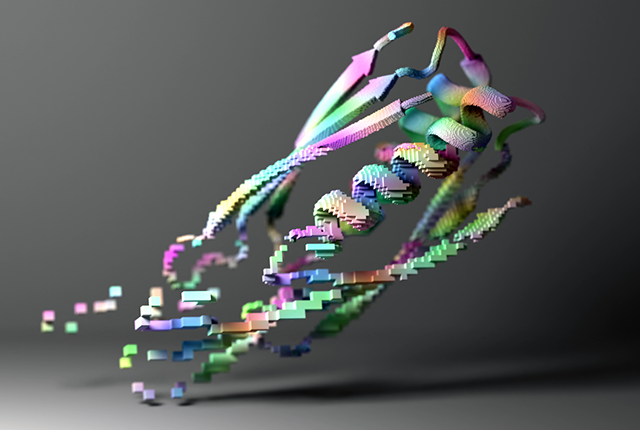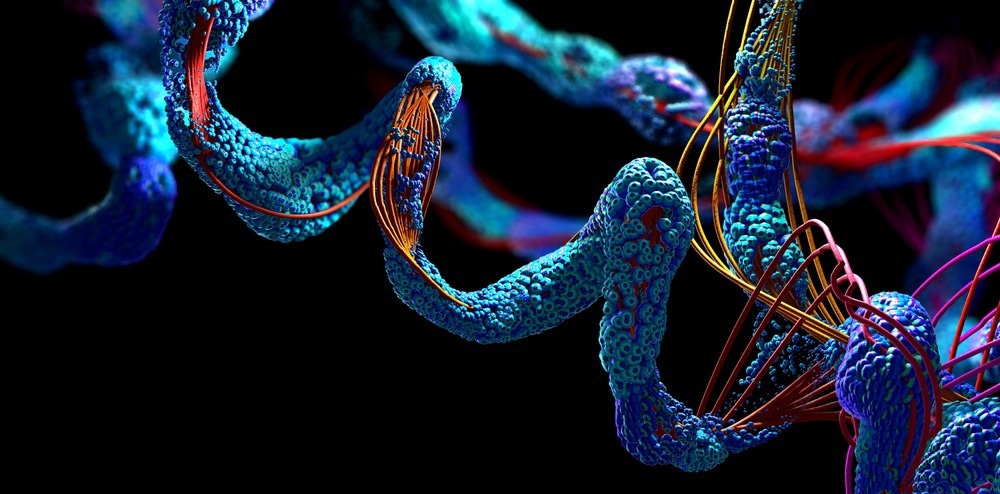Reviewed by Danielle Ellis, B.Sc.Sep 16 2022
Machine learning has completely changed protein structure prediction over the past two years. A comparable revolution in protein design is now described in three studies published in Science.
 Proteins designed with an ultra-rapid software tool called ProteinMPNN were much more likely to fold up as intended. Image Credit: Ian Haydon
Proteins designed with an ultra-rapid software tool called ProteinMPNN were much more likely to fold up as intended. Image Credit: Ian Haydon
The University of Washington, School of Medicine’s biologists demonstrate in the new publications how machine learning can produce protein molecules far more precisely and swiftly than was previously achievable. The researchers anticipate that this development will result in numerous novel vaccinations, drugs, carbon capture techniques, and biomaterials that are sustainable.
Proteins are fundamental across biology, but we know that all the proteins found in every plant, animal, and microbe make up far less than one percent of what is possible. With these new software tools, researchers should be able to find solutions to long-standing challenges in medicine, energy, and technology.”
David Baker, Study Senior Author and Professor, Biochemistry, University of Washington School of Medicine
Baker was also a recipient of a 2021 Breakthrough Prize in Life Sciences.
Since they are necessary for the development, maintenance, and growth of all living organisms, proteins are frequently referred to as the “building blocks of life.” They participate in almost all cellular processes, such as cell growth, division, and repair. Long chemical chains known as amino acids make up proteins.
A protein’s three-dimensional structure is determined by the order of its amino acids. The protein must have this complex form in order to work.

Image Credit: Christoph Burgstedt/Shutterstock.com
AlphaFold and RoseTTAFold, two potent machine learning algorithms, have recently been developed to predict the precise shapes of natural proteins based just on their amino acid sequences.
The branch of artificial intelligence known as machine learning enables machines to learn from information without explicit programming. Complex scientific problems that are too tough for humans to comprehend can be modeled using machine learning.
The members of Baker’s team divided the problem of protein creation into three pieces and employed novel software solutions for each to create proteins that go beyond the proteins found in nature.
A fresh protein shape needs to be created first. The scientists demonstrated how artificial intelligence can create new protein forms in two methods in an article that was released on July 21st, 2022, in the journal Science.
The first one, called “hallucination,” is comparable to DALL-E or other generative AI tools that generate output in response to straightforward commands. The second referred to as “inpainting,” is comparable to the autocomplete function present in contemporary search bars.
Second, the researchers created a novel method for creating amino acid sequences to hasten the process. The ProteinMPNN software tool, which was described in the Science edition of September 15, runs in roughly one second. That outperforms the previous best software by more than 200 times. It produces better outcomes than earlier tools, and it doesn’t need to be customized by a specialist to work.
“Neural networks are easy to train if you have a ton of data, but with proteins, we don’t have as many examples as we would like. We had to go in and identify which features in these molecules are the most important. It was a bit of trial and error,” said project scientist Justas Dauparas, a postdoctoral fellow at the Institute for Protein Design.
Third, the group separately evaluated whether the proposed amino acid sequences were likely to fold into the desired shapes using AlphaFold, a technology created by Alphabet’s DeepMind.
“Software for predicting protein structures is part of the solution but it cannot come up with anything new on its own,” explained Dauparas.
ProteinMPNN is to protein design what AlphaFold was to protein structure prediction.”
David Baker, Study Senior Author and Professor, Biochemistry, University of Washington School of Medicine
A team from the Baker lab demonstrated in a different publication that will be published in Science on September 15 that the combination of new machine learning technologies could dependably produce novel proteins that worked in the lab.
“We found that proteins made using ProteinMPNN were much more likely to fold up as intended, and we could create very complex protein assemblies using these methods,” said project scientist Basile Wicky, a postdoctoral fellow at the Institute for Protein Design.
Nanoscale rings that the scientists claim could become components for unique nanomachines were created among the novel proteins. The rings, which had widths about a billion times smaller than a poppy seed, were examined using electron microscopes.
This is the very beginning of machine learning in protein design. In the coming months, we will be working to improve these tools to create even more dynamic and functional proteins.”
David Baker, Study Senior Author and Professor, Biochemistry, University of Washington School of Medicine
Source:
Journal reference:
Wang, J, et al. (2022) Scaffolding protein functional sites using deep learning. Science. doi.org/10.1126/science.abn2100.